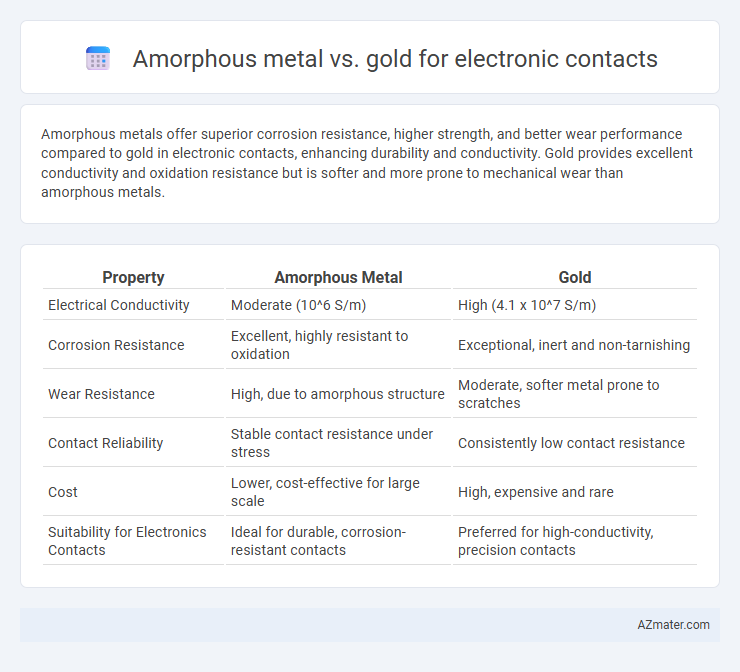Amorphous metals offer superior corrosion resistance, higher strength, and better wear performance compared to gold in electronic contacts, enhancing durability and conductivity. Gold provides excellent conductivity and oxidation resistance but is softer and more prone to mechanical wear than amorphous metals.
Table of Comparison
| Property | Amorphous Metal | Gold |
|---|---|---|
| Electrical Conductivity | Moderate (10^6 S/m) | High (4.1 x 10^7 S/m) |
| Corrosion Resistance | Excellent, highly resistant to oxidation | Exceptional, inert and non-tarnishing |
| Wear Resistance | High, due to amorphous structure | Moderate, softer metal prone to scratches |
| Contact Reliability | Stable contact resistance under stress | Consistently low contact resistance |
| Cost | Lower, cost-effective for large scale | High, expensive and rare |
| Suitability for Electronics Contacts | Ideal for durable, corrosion-resistant contacts | Preferred for high-conductivity, precision contacts |
Introduction to Electronic Contacts Materials
Amorphous metals offer superior corrosion resistance and wear properties compared to traditional gold contacts in electronic devices, enhancing durability and longevity under harsh conditions. Gold remains a preferred material due to its excellent electrical conductivity and oxidation resistance, ensuring reliable signal transmission in low-voltage applications. Advances in amorphous metal technology provide cost-effective alternatives with improved mechanical strength, making them increasingly competitive for electronic contact materials.
Overview of Amorphous Metals
Amorphous metals, also known as metallic glasses, feature a disordered atomic structure that provides superior wear resistance, high strength, and excellent corrosion resistance compared to traditional crystalline metals like gold. These properties make amorphous metals promising for electronic contacts, offering improved durability and reduced oxidation without the high cost associated with gold. Their unique non-crystalline structure allows for consistent electrical conductivity and enhanced mechanical performance in demanding electronic environments.
Properties of Gold in Electronics
Gold exhibits exceptional electrical conductivity and resistance to corrosion, making it a preferred choice for reliable electronic contacts. Its excellent ductility allows thin plating on connectors, ensuring consistent performance under mechanical stress and preventing oxidation-related failures. These properties enable gold to maintain low contact resistance and long-term durability in critical electronic components.
Conductivity Comparison: Amorphous Metal vs Gold
Amorphous metals exhibit lower electrical conductivity compared to gold, typically ranging between 1 to 5 million S/m, while gold boasts a high conductivity of approximately 45.2 million S/m at room temperature. The superior conductivity of gold ensures minimal electrical resistance and efficient signal transmission in electronic contacts, making it a preferred choice despite its higher cost. However, amorphous metals provide enhanced mechanical strength and corrosion resistance, which can be advantageous in specific electronic applications requiring durability over maximum conductivity.
Wear and Corrosion Resistance
Amorphous metals exhibit superior wear and corrosion resistance compared to gold, making them highly suitable for electronic contacts subjected to abrasive environments. Their non-crystalline atomic structure imparts exceptional hardness and minimizes oxidation, which significantly extends the contact's operational lifespan. Gold, while highly conductive and corrosion-resistant, tends to be softer and more prone to wear under mechanical stress, limiting its durability in demanding applications.
Cost Efficiency and Material Availability
Amorphous metals offer superior cost efficiency compared to gold in electronics contacts due to their lower raw material costs and easier manufacturing processes. The abundant availability of precursor elements like iron, nickel, and zirconium further reduces supply chain constraints, unlike gold, which faces high market volatility and limited reserves. These factors make amorphous metals a more sustainable and economically viable choice for high-performance electronic contacts in mass production.
Longevity and Reliability Factors
Amorphous metals exhibit superior longevity and reliability for electronic contacts due to their non-crystalline structure, which provides enhanced corrosion resistance and reduced wear compared to gold. Unlike gold, amorphous metals maintain stable electrical conductivity under repeated mechanical stress and harsh environmental conditions, minimizing contact degradation over time. The absence of grain boundaries in amorphous metals reduces the risk of fatigue and enhances the lifespan of electronic components in demanding applications.
Application Suitability in Electronics
Amorphous metals offer superior wear resistance and excellent corrosion resistance, making them suitable for high-reliability electronic contacts subject to frequent mechanical stress. Gold provides exceptional electrical conductivity and oxidation resistance, ideal for low-resistance connections in low-current, precision applications. Amorphous metals are preferred in harsh environments where durability is critical, while gold excels in environments demanding stable, long-term conductive performance.
Environmental and Manufacturing Considerations
Amorphous metals offer significant environmental advantages over gold in electronic contacts due to their lower mining impact and enhanced recyclability, reducing ecological footprint and resource depletion. Manufacturing processes involving amorphous metals typically require less energy and utilize fewer toxic chemicals compared to gold plating, resulting in diminished hazardous waste generation. These factors position amorphous metals as a sustainable alternative for electronic contact materials while maintaining high conductivity and corrosion resistance.
Future Trends in Contact Material Selection
Amorphous metals offer superior corrosion resistance, high strength, and excellent electrical conductivity compared to traditional gold contacts, positioning them as a promising alternative for future electronic devices. Advancements in nanostructuring and alloy composition are enhancing the wear resistance and thermal stability of amorphous metal contacts, addressing gold's limitations in harsh operating environments. The shift towards sustainable and cost-effective materials drives industry adoption of amorphous metals, supporting the development of next-generation electronics with improved longevity and performance.

Infographic: Amorphous metal vs Gold for Electronics contact
 azmater.com
azmater.com